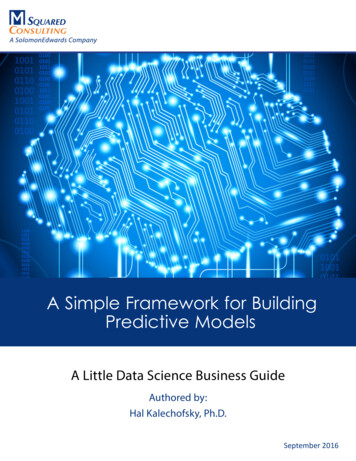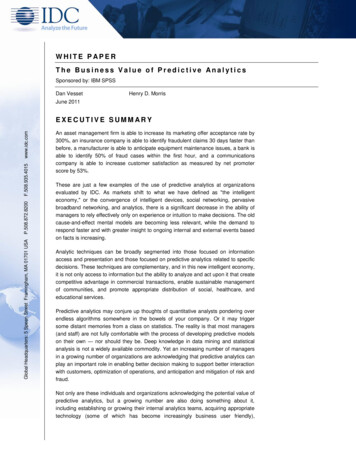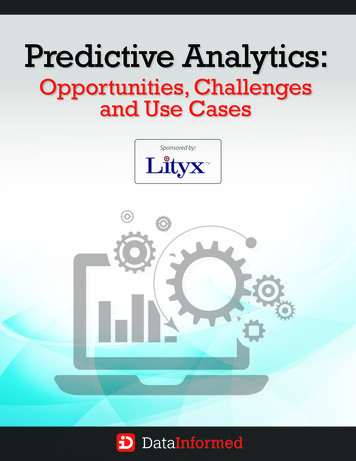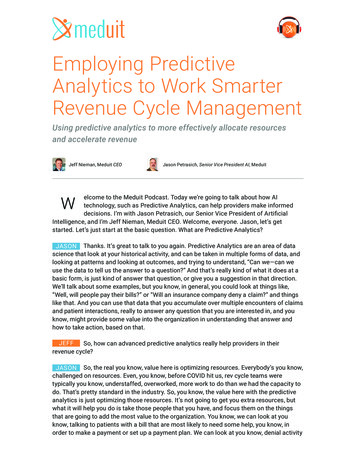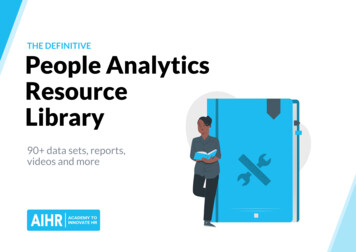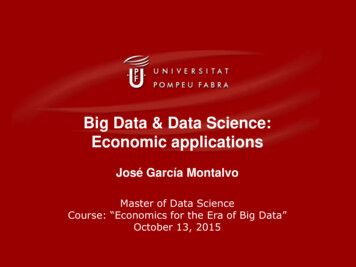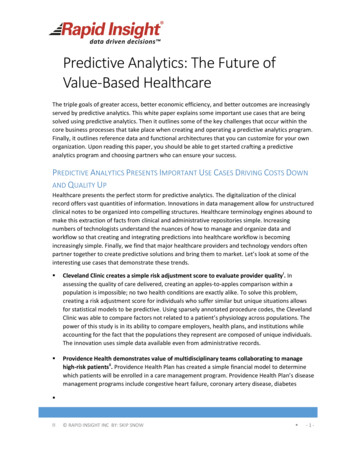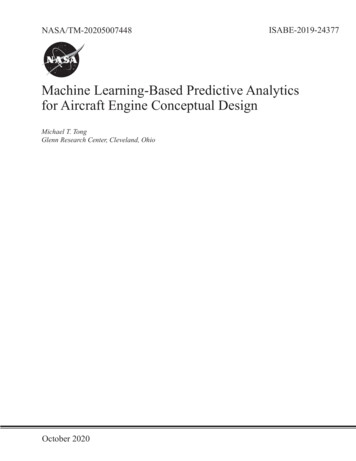
Transcription
NASA/TM-20205007448ISABE-2019-24377Machine Learning-Based Predictive Analyticsfor Aircraft Engine Conceptual DesignMichael T. TongGlenn Research Center, Cleveland, OhioOctober 2020
NASA STI Program . . . in ProfileSince its founding, NASA has been dedicatedto the advancement of aeronautics and space science.The NASA Scientific and Technical Information (STI)Program plays a key part in helping NASA maintainthis important role.The NASA STI Program operates under the auspicesof the Agency Chief Information Officer. It collects,organizes, provides for archiving, and disseminatesNASA’s STI. The NASA STI Program provides accessto the NASA Technical Report Server—Registered(NTRS Reg) and NASA Technical Report Server—Public (NTRS) thus providing one of the largestcollections of aeronautical and space science STI inthe world. Results are published in both non-NASAchannels and by NASA in the NASA STI ReportSeries, which includes the following report types: TECHNICAL PUBLICATION. Reports ofcompleted research or a major significant phaseof research that present the results of NASAprograms and include extensive data or theoreticalanalysis. Includes compilations of significantscientific and technical data and informationdeemed to be of continuing reference value.NASA counter-part of peer-reviewed formalprofessional papers, but has less stringentlimitations on manuscript length and extent ofgraphic presentations.TECHNICAL MEMORANDUM. Scientificand technical findings that are preliminary or ofspecialized interest, e.g., “quick-release” reports,working papers, and bibliographies that containminimal annotation. Does not contain extensiveanalysis. CONTRACTOR REPORT. Scientific andtechnical findings by NASA-sponsoredcontractors and grantees. CONFERENCE PUBLICATION. Collectedpapers from scientific and technicalconferences, symposia, seminars, or othermeetings sponsored or co-sponsored by NASA. SPECIAL PUBLICATION. Scientific,technical, or historical information fromNASA programs, projects, and missions, oftenconcerned with subjects having substantialpublic interest. TECHNICAL TRANSLATION. Englishlanguage translations of foreign scientific andtechnical material pertinent to NASA’s mission.For more information about the NASA STIprogram, see the following: Access the NASA STI program home page athttp://www.sti.nasa.gov E-mail your question to help@sti.nasa.gov Fax your question to the NASA STIInformation Desk at 757-864-6500 Telephone the NASA STI Information Desk at757-864-9658 Write to:NASA STI ProgramMail Stop 148NASA Langley Research CenterHampton, VA 23681-2199
NASA/TM-20205007448ISABE-2019-24377Machine Learning-Based Predictive Analyticsfor Aircraft Engine Conceptual DesignMichael T. TongGlenn Research Center, Cleveland, OhioPrepared for the24th ISABE Conference (ISABE 2019)sponsored by the International Society for Airbreathing EnginesCanberra, Australia, September 22–27, 2019National Aeronautics andSpace AdministrationGlenn Research CenterCleveland, Ohio 44135October 2020
AcknowledgmentsThe NASA Advanced Air Transport Technology Project of theAdvanced Air Vehicles Program supports the work presented in this paper.This work was sponsored by the Advanced Air Vehicle Programat the NASA Glenn Research CenterTrade names and trademarks are used in this report for identificationonly. Their usage does not constitute an official endorsement,either expressed or implied, by the National Aeronautics andSpace Administration.Level of Review: This material has been technically reviewed by technical management.Available fromNASA STI ProgramMail Stop 148NASA Langley Research CenterHampton, VA 23681-2199National Technical Information Service5285 Port Royal RoadSpringfield, VA 22161703-605-6000This report is available in electronic form at http://www.sti.nasa.gov/ and http://ntrs.nasa.gov/
Machine Learning-Based Predictive Analyticsfor Aircraft Engine Conceptual DesignMichael T. TongNational Aeronautics and Space AdministrationGlenn Research CenterCleveland, Ohio 44135AbstractBig data and artificial intelligence/machine learning are transforming the global businessenvironment. Data is now the most valuable asset for enterprises in every industry. Companies are usingdata-driven insights for competitive advantage. With that, the adoption of machine learning-based dataanalytics is rapidly taking hold across various industries, producing autonomous systems that supporthuman decision-making. This work explored the application of machine learning to aircraft engineconceptual design. Supervised machine-learning algorithms for regression and classification wereemployed to study patterns in an existing, open-source database of production and research turbofanengines, and resulting in predictive analytics for use in predicting performance of new turbofan designs.Specifically, the author developed machine learning-based analytics to predict cruise thrust specific fuelconsumption (TSFC) and core sizes of high-efficiency turbofan engines, using engine design parametersas the input. The predictive analytics were trained and deployed in Keras, an open-source neural networksapplication program interface (API) written in Python, with Google’s TensorFlow (an open source libraryfor numerical computation) serving as the backend engine. The promising results of the predictiveanalytics show that machine-learning techniques merit further exploration for application in aircraftengine conceptual Neapplication program interfacebypass ratioArtificial Neural NetworksDeep Neural Networkshigh-pressure compressorHPC last-stage blade height (core size)overall pressure ratioSupport Vector Machinethrust specific fuel consumptionSVM parameter, controls the tradeoff between misclassification error and separation marginSVM parameter, controls the tradeoff between error due to bias and variance in the modelnumber of hidden layersnumber of neurons in each hidden layerNASA/TM-202050074481
1.0IntroductionThe aviation industry is capital intensive, and is subject to stringent environmental and safetyregulations. To minimize risk, technological improvements of aircraft engines are generally madeincrementally, drawing heavily from experiences and lessons learned. Engine companies have generatedand collected large amounts of data over the years. These big data, from various sources such as thedatabase of currently manufactured engines, current development projects, previously completeddevelopment projects, and the designs that were not manufactured, are valuable resources of intelligencethat can support new engine development. With increasing computational power and employing machinelearning, data can be mined to provide valuable insights that could bring high levels of efficiency toengine conceptual design.The author’s previous study (Ref. 1) showed that machine learning-based analytics could be aneffective tool for turbofan core-size prediction. In this work, the focus was on the application of machinelearning analytics for turbofan TSFC prediction. Supervised machine-learning algorithms for regressionwere employed to find patterns in the database of 183 manufactured engines and engines that werestudied previously in various NASA aeronautics projects. Analytics for turbofan cruise TSFC predictionwas built. The objective was to determine if machine learning-based predictive analytics could be aneffective tool for turbofan engine TSFC prediction at the conceptual design stage. In addition to the TSFCpredictive-analytics development, the author slightly modified the engine core-size predictive analyticsthat was developed in Reference 1, to improve its prediction accuracy. The modification accounted for anadditional (the fourth) input parameter, engine technology level.Both TSFC and core-size are key design parameters for any new aircraft engine. TSFC is a measureof fuel efficiency. It affects aircraft range and is a key element in fuel burn. TSFC is also an indicator ofengine operating cost. To be able to predict TSFC rapidly and accurately would help to identify the bestengine design expeditiously amongst several candidates. Engine core size can affect fuel efficiency. To beable to predict engine core size rapidly and accurately in the design space exploration would facilitateengine core architecture selection in the conceptual stage of engine development.2.0Engine DatabaseThe basic engine architecture in this study was an axial-compressor turbofan. The engine databaseconsisted of 144 manufactured engines (Refs. 2 to 8) and 39 engines that were studied previously invarious NASA aeronautics projects. These commercial engines span the era from the mid-1960s to mid2010s. The database captures over half-a-century of engine technology improvements and lessonslearned, which injects realism to the predictive analytics. The NASA engine data were the system-studyresults for various NASA aeronautics projects (Refs. 9 to 15). The engine database is shown in theAppendix (Table IX).3.0Machine Learning AlgorithmsMachine learning is a branch of artificial intelligence that uses statistical technique and mathematicalalgorithms to enable a machine to learn from data, to analyze data patterns, and to make decisions withminimal human intervention. In this work, the author developed a machine learning-based predictiveanalytics for TSFC predictions.For engine core-size prediction the support vector machine algorithm (SVM) was used. In a previousstudy (Ref. 1), of the three algorithms studied, SVM offered the best accuracy and the lowest uncertaintyfor binary classification.NASA/TM-202050074482
3.1Support Vector Machine (SVM) for Engine Core-Size ClassificationIn this work, engine core-size prediction was treated as a classification problem, since the actualengine core sizes for the commercial engines were not publicly available. A machine-learning predictiveanalytics based on SVM (Ref. 16), which was developed in previous study (Ref. 1), was slightly modifiedfor engine core-size classification, i.e. to label engine core size as acceptable or unacceptable. Themodification accounted for an additional (the fourth) input parameter, engine technology level, asdescribed in the next section. The algorithm is also described in Reference 1.3.2Deep Neural Network (DNN) for Cruise TSFC RegressionCruise TSFC prediction was considered a regression problem. Due to the high degree of accuracyrequired for the TSFC prediction, its predictive analytics was developed using a deep-learning neuralnetwork (DNN) that established correlations between the input variables and the TSFC. DNN isessentially an artificial neural network (Ref. 17) with several hidden layers. In this work, the DNNconsisted of one input layer, six hidden layers, and one output layer. Each subsequent hidden layer,consisted of six neurons, progressively extracting higher-level features from the input. These layers usedbackpropagation to optimize the weights of the input variables to improve the predictive power of theanalytics. A scaled exponential linear unit (SELU) function (Ref. 18) was used for the activation functionin the hidden layers, defined ��) 𝑠𝑠𝑠𝑠𝑠𝑠𝑠𝑠𝑠𝑠 𝑥𝑥𝛼𝛼𝑒𝑒 𝛼𝛼𝑖𝑖𝑖𝑖 𝑥𝑥 0𝑖𝑖𝑖𝑖 𝑥𝑥 0where x weighted sum of input variablesα 1.67326, a predefined constant to preserve the mean and variance of the inputsscale 1.05070, a predefined constant to preserve the mean and variance of the inputsDropout regularization technique (Ref. 19), where neuron outputs are dropped out randomly, wasapplied between the fifth and the sixth hidden layers, and between the sixth hidden layer and the outputlayer, to prevent the DNN from overfitting the training data. The dropout rate was set to 20 percent. Agrid-search routine was used to determine number of epochs, batch size that give the lowest training error.The number of epochs determined the number of times an entire training dataset was passed forward andbackward through the DNN. Batch size referred to the number of training samples used for each iteration.The Adam optimization algorithm (Ref. 20) was used for this effort. The predictive analytics was trainedand deployed in Keras (Ref. 18), an open-source neural networks API written in Python, with Google’sTensorFlow (Ref. 21) serving as the backend engine. Keras provided the building blocks for developingthe deep-learning analytics, and TensorFlow handled the tensor computations and manipulations.TensorFlow is an open source library for numerical computation and large-scale machine learning.4.0Predictive AnalyticsWith the machine learning algorithms described in the previous section, the author developed twotypes of predictive analytics: a regression model for turbofan cruise TSFC prediction, and a classificationmodel for turbofan core-size prediction. Similar to Reference 1, core sizes of all the manufactured enginesare assumed to be 0.5 in. or larger. For the NASA engines, core sizes were classified according to theblade-height data obtained from the system studies. The Python programming language (script andlibraries) was used to develop both analytics.NASA/TM-202050074483
Input engine parameters for cruise TSFC predictive analytics were: OPR at sea level static conditionBPR at sea level static conditionSea level static thrustCruise Mach numberCruise altitudeEngine technology level (engine certified year)Even though turbine inlet temperature (T4), turbine cooling, and turbomachinery efficiencies wereimportant design parameters, these engine data were not publicly available. However, their highdependence on engine technology (such as tip-clearance control and advanced materials) are wellunderstood. Since in general, “engine certified year” is a good indicator of engine technology level, it wasused to account for T4, turbine cooling, and turbomachinery efficiencies. For the NASA engines, thecertification years were assumed to be 2025, 2030, and 2040 respectively to correspond with the N 1,N 2, and N 3 timeframes. These timeframes were directed at three generations of aircraft in the near,mid, and far terms that were studied under NASA aeronautics projects. The sea-level flight condition forOPR and BPR was chosen for data availability; majority design data for these two parameters are publiclyavailable at the sea-level flight condition.For engine core-size predictive analytics, the binary classifier that was developed in Reference 1 wasslightly modified to account for an additional (the fourth) input parameter, engine technology level.Input engine parameters for core-size predictive analytics were: OPR at sea level static conditionBPR at sea level static conditionSea level static thrustEngine technology level (engine certified year)Two predictive analytics were built with the machine-learning algorithms described in the previoussection. The predictive analytics for cruise TSFC was a regression model. The predictive analytics forengine core-size was a binary classifier. The core sizes were categorized into two classes: 0 and 1(correspond to acceptable and unacceptable core sizes), according to the engine core size (h), as shown inTable I.TABLE I.—CATEGORIES OF ENGINECORE-SIZE CLASSIFIERTwo ble)h 0.50 in.h 0.50 in.4
TABLE II.—TRAINING-TESTING DATASETSPLIT FOR THE PREDICTIVE ANALYTICSTraining datasetTesting dataset(no. of engines)(no. of engines)137(75% of dataset)46(25% of dataset)Training and building the predictive analytics involved machine learning algorithms and data science.The approach consisted of three steps: dataset preparation; building, training, and cross-validation of thepreliminary analytics; and building, training, and evaluation of the final analytics. Dataset preparationThe engine dataset was shuffled randomly (using pseudo-random number generator) and divided intotwo datasets: the training set and the testing set. The training set was used to train, cross-validate, andbuild predictive analytics. The testing set consisted of the remaining engines that were unseen by thepredictive analytics, and was retained for the final evaluation of the predictive analytics. Table II depictsthe training-testing dataset split. Building, training, and cross-validation of the preliminary analyticsThe building, training and cross-validation of the analytics were conducted using the training dataset.Within the training dataset (137 engines), a 6-fold cross-validation procedure was used to conduct apreliminary evaluation and to fine-tune the analytics. The training dataset was randomly split into 6groups: 5 groups were used to train the analytics and 1 group was used to cross-validate the analytics.This process was repeated 6 times so that each of the 6 groups got the chance to be used for training andvalidation. The performance measure was then the average of the values, in terms of the mean andstandard deviation, computed in the iteration loop. Building, training, and evaluation of the final analyticsCross-validation was no longer needed for this step, i.e., all 137 engine data were used to build andtrain the predictive analytics. The analytics were then used to predict the cruise TSFC and core sizes inthe testing dataset (46 engines), and the results were compared with the testing dataset.5.0Predictive Results5.1Preliminary Training and Cross-Validation ResultsDuring preliminary training and cross validation, the algorithm parameters and predictionuncertainties were determined. Using grid-search routines, the algorithms parameters that give thesmallest errors for both analytics are shown in Table III.NASA/TM-202050074485
TABLE III.—ALGORITHMS USED AND THEIR PARAMETERSAlgorithmsParametersDNN for TSFC predictionNh 6, Ne 6, epoch 8386, batch size 16, dropout rate forthe 5th and 6th hidden layers 20%SVM for core-size predictionC 10, ϒ 1TABLE IV.—CROSS-VALIDATION RESULTSAlgorithmsAccuracyUncertainty(average)95% confidence interval(two standard deviations)DNN for cruise TSFC prediction97.9%3.5%SVM for core-size prediction97.8%4.3%The prediction accuracy for TSFC measured how close the prediction was to the test data. Theuncertainty was defined at 95 percent confidence level, i.e., two standard deviations for normal datadistribution. The cross validation results are shown in Table IV. For the core-size prediction, theclassification accuracy of the algorithms was defined as the number of correct predictions made as apercentage of all predictions made. Its uncertainty was also defined at 95 percent confidence interval. Theresults show close to 98 percent prediction accuracy for both TSFC and core sizes, with 3.5 and4.3 percent uncertainties, respectively.5.2Evaluation of the Final Predictive Analytics With Testing Dataset5.2.1TSFC PredictionThe final predictive analytics, built with the parameters determined during the preliminary trainingand with all 137 training data (i.e., no cross validation), were then used to predict the engine TSFC andcore sizes in the testing dataset (the 46 engines unseen by the analytics). Table V summarizes theevaluation results of the TSFC predictive analytics. On average, the prediction accuracy is high, at98.3 percent. Table VI shows the detailed comparison of the prediction and the testing data. Theprediction accuracy exceeds 95 percent for 45 of the 46 engines. The prediction accuracy for the oneengine is only slightly below 95 percent. The performance of the deep-learning model over time duringtraining is shown in Figure 1. It shows the mean squared error decreases consistently and converges overtraining epochs. The DNN model performs well consistently for both the training and testing datasets. Anepoch is a measure of the number of times an entire dataset is passed forward and backward through theneural network.NASA/TM-202050074486
TABLE V.—EVALUATION RESULTS OF THECRUISE TSFC PREDICTIVE )(minimum)98.3%100.0%94.8%Figure 1.—Deep Neural Network model accuracy on trainingand testing datasets.TABLE VI.—COMPARISON OF TSFC PREDICTIONS WITH TESTING DATASETAverage accuracy 98.3 percentSFW – Subsonic Fixed Wing projectERA – Environmentally Responsible Aviation projectNASA/TM-20205007448lowest accuracy7
5.2.2Core-Size PredictionTable VII shows the evaluation results of the core-size predictive analytics. The analytics performsremarkably; it has a perfect prediction accuracy. More importantly, it also predicts unacceptable enginecore sizes (h 0.5 in.) with perfect accuracy. Table VIII shows the detailed comparison of the predictionand the testing data.TABLE VII.—EVALUATION RESULTS OF THEENGINE CORE-SIZE PREDICTIVE ANALYTICSCore sizeAccuracyNo. of enginesNo. of engines(data)(predictions)h 0.5 in.4040100%h 0.5 in.66100%4646100%OverallTABLE VIII.—COMPARISON OF ENGINE CORE-SIZE PREDICTIONS WITH TESTING DATASETh 0.50 in.SFW – Subsonic Fixed Wing projectERA – Environmentally Responsible Aviation projectAATT – Advanced Air Transport Technology projectNASA/TM-20205007448h 0.50 in.8
6.0ConclusionsThe author developed two machine-learning predictive analytics for turbofan TSFC and core-sizepredictions, respectively. The development used the database of 183 manufactured engines and enginesthat were studied previously in NASA aeronautics projects. The TSFC predictive analytics has an averageaccuracy of 98.3 percent, with 3.5 percent uncertainty. The engine core-size predictive analytics has anoverall accuracy of 100 percent, with 4.3 percent uncertainty. Overall, both predictive analytics showremarkable prediction accuracy.To further improve the accuracy (and reduce the uncertainty) of TSFC prediction, the database needsto be expanded. However, the limitation of publicly available engine data is a challenge to overcome.Overall, the results show that by bringing together sufficient (big) high quality data, robust machinelearning algorithms, and data science, machine learning-based predictive analytics can be an effective toolfor engine design-space exploration during the conceptual design phase. It would help to identify the bestengine design expeditiously amongst several candidates. The promising results of the predictive analyticsshow that machine-learning techniques merit further exploration for application in aircraft engineconceptual design.References1. Tong, M.T., “Using Machine Learning To Predict Core Sizes of High-Efficiency Turbofan Engines,”GT2019-91432, ASME Turbo-Expo 2019, June 17-21, 2019.2. Daly, M., “Jane’s Aero-Engine,” 2017-2018.3. Meier, N., “Civil turbojet/turbofan specifications.” http://www.jet-engine.net/civtfspec.html.Accessed August, 2018.4. GE Aviation. https://www.geaviation.com/commercial5. Pratt and Whitney. cts/commercial-engines6. Rolls Royce. civil-aerospace7. CFM International. https://www.cfmaeroengines.com/8. International Civil Aviation Organization, “ICAO Aircraft Emissions Databank.” May, 2018.9. Guynn, M.D., Berton, J.J., Fisher, K.L., Haller, W.J., Tong, M., Thurman, D.R., “Engine ConceptualStudy for an Advanced Single-Aisle Transport,” NASA/TM—2009-215784, August 2009.10. Guynn, M.D., Berton, J.J., Fisher, K.L., Haller, W.J., Tong, M., Thurman, D.R., “Analysis ofTurbofan Design Options for an Advanced Single-Aisle Transport Aircraft,” AIAA 2009-6942,September 2009.11. Guynn, M. D., Berton, J.J., Fisher, K.L., Haller, W.J., Tong, M., Thurman, D.R, “Refined Explorationof Turbofan Design Options for an Advanced Single-Aisle Transport,” NASA/TM—2011-216883,January 2011.12. Guynn, M.D., Berton, J.J., Tong, M.T., Haller, W.J., “Advanced Single-Aisle Transport PropulsionDesign Options Revisited,” AIAA 2013-4330, August 2013.13. Nickol, C.L. and Haller W.J., “Assessment of the Performance Potential of Advanced SubsonicTransport Concepts for NASA’s Environmentally Responsible Aviation Project,” AIAA 2016-1030,January 2016.14. Collier, F., Thomas, R., Burley, C., Nickol, C., Lee, C.M., Tong, M., “Environmentally ResponsibleAviation – Real Solutions for Environmental Challenges Facing Aviation,” 27th InternationalCongress of the Aeronautical Sciences, September, 2010.15. Jones, S.M., Haller, W.J., Tong, M.T., “An N 3 Technology Level Reference Propulsion System,”NASA/TM—2017-219501, May, 2017.NASA/TM-202050074489
16. Ng, A., “Support Vector Machines.” CS229 lecture notes. Stanford otes3.pdf17. Ng, A., “Machine Learning,” Coursera online course lecture ing18. Chollet, François and others, “Keras.” Retrieved on February 22, 2019 from: https://keras.io/19. Hinton, G.E., Krizhevsky, A., Srivastava, N., Sutskever, I., & Salakhutdinov, R., “Dropout: A simpleWay to Prevent Neural Networks from Overfitting.” Journal of Machine Learning Research, 15,1929-1958. June, 2014.20. Kingma, D. P. and Ba, J., “Adam: A Method for Stochastic Optimization,” International Conferenceon Learning Representations, May 2015.21. Google, “TensorFlow: Large-Scale Machine Learning on Heterogeneous Distributed Systems.Retrieved on February 20, 2019 from: https://www.tensorflow.org/NASA/TM-2020500744810
Appendix. Engine DatabaseTABLE IX.—ENGINE DATABASESFW – Subsonic Fixed Wing projectERA – Environmentally Responsible Aviation projectAATT – Advanced Air Transport Technology projectNASA/TM-20205007448h 0.50 in.11
TABLE IX.—Continued.SFW – Subsonic Fixed Wing projectERA – Environmentally Responsible Aviation projectAATT – Advanced Air Transport Technology projectNASA/TM-20205007448h 0.50 in.12
TABLE IX.—Concluded.h 0.50 in.SFW – Subsonic Fixed Wing projectERA – Environmentally Responsible Aviation projectAATT – Advanced Air Transport Technology projectNASA/TM-20205007448h 0.50 in.13
engines, and resulting in predictive analytics for u se in predicting performance of new turbofan designs. Specifically, the author developed machine learning -based analytics to predict cruise thrust specific fuel consumption (TSFC) and core sizes of high-efficiency turbofan engines,
